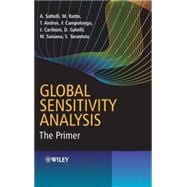
What is included with this book?
| Preface | |
| Introduction to Sensitivity Analysi | |
| Models and Sensitivity Analysis | |
| Definition | |
| Models | |
| Models and Uncertainty | |
| How to Set Up Uncertainty and Sensitivity Analyses | |
| Implications for Model Quality | |
| Methods and Settings for Sensitivity Analysis - An Introduction | |
| Local versus Global | |
| A Test Model | |
| Scatterplots versus Derivatives | |
| Sigma-normalized Derivatives | |
| Monte Carlo and Linear Regression | |
| Conditional Variances - First Path | |
| Conditional Variances - Second Path | |
| Application to Model (3) | |
| A First Setting: 'Factor Prioritization' | |
| Nonadditive Models | |
| Higher-order Sensitivity Indices | |
| Total Effects | |
| A Second Setting: 'Factor Fixing' | |
| Rationale for Sensitivity Analysis | |
| Treating Sets | |
| Further Methods | |
| Elementary Effect Test | |
| Monte Carlo Filtering | |
| Nonindependent Input Factors | |
| Possible Pitfalls for a Sensitivity Analysis | |
| Concluding Remarks | |
| Exercises | |
| Answers | |
| Additional Exercises | |
| Solutions to Additional Exercises | |
| Experimental Designs | |
| Introduction | |
| Dependency on a Single Parameter | |
| Sensitivity Analysis of a Single Parameter | |
| Random Values | |
| Stratified Sampling | |
| Mean and Variance Estimates for Stratified Sampling | |
| Sensitivity Analysis of Multiple Parameters | |
| Linear Models | |
| One-at-a-time (OAT) Sampling | |
| Limits on the Number of Influential Parameters | |
| Fractional Factorial Sampling | |
| Latin Hypercube Sampling | |
| Multivariate Stratified Sampling | |
| Quasi-random Sampling with Low-discrepancy Sequences | |
| Group Sampling | |
| Exercises | |
| Exercise Solutions | |
| Elementary Effects Method | |
| Introduction | |
| The Elementary Effects Method | |
| The Sampling Strategy and its Optimization | |
| The Computation of the Sensitivity Measures | |
| Working with Groups | |
| The EE Method Step by Step | |
| Conclusions | |
| Exercises | |
| Solutions | |
| Variance-based Methods | |
| Different Tests for Different Settings | |
| Why Variance? | |
| Variance-based Methods. A Brief History | |
| Interaction Effects | |
| Total Effects | |
| How to Compute the Sensitivity Indices | |
| FAST and Random Balance Designs | |
| Putting the Method to Work: the Infection Dynamics Model | |
| Caveats | |
| Exercises | |
| Factor Mapping and Metamodelling | |
| Introduction | |
| Monte Carlo Filtering (MCF) | |
| Implementation of Monte Carlo Filtering | |
| Pros and Cons | |
| Exercises | |
| Solutions | |
| Examples | |
| Metamodelling and the High-Dimensional Model Representation | |
| Estimating HDMRs and Metamodels | |
| A Simple Example | |
| Another Simple Example | |
| Exercises | |
| Solutions to Exercises | |
| Conclusions | |
| Sensitivity Analysis: from Theory to Practice | |
| Example 1: a Composite Indicator | |
| Setting the Problem | |
| A Composite Indicator Measuring Countries' Performance in Environmental Sustainability | |
| Selecting the Sensitivity Analysis Method | |
| The Sensitivity Analysis Experiment and its Results | |
| Conclusions | |
| Example 2: Importance of Jumps in Pricing Options | |
| Setting the Problem | |
| The Heston Stochastic Volatility Model with Jumps | |
| Selecting a Suitable Sensitivity Analysis Method | |
| The Sensit | |
| Table of Contents provided by Publisher. All Rights Reserved. |
The New copy of this book will include any supplemental materials advertised. Please check the title of the book to determine if it should include any access cards, study guides, lab manuals, CDs, etc.
The Used, Rental and eBook copies of this book are not guaranteed to include any supplemental materials. Typically, only the book itself is included. This is true even if the title states it includes any access cards, study guides, lab manuals, CDs, etc.